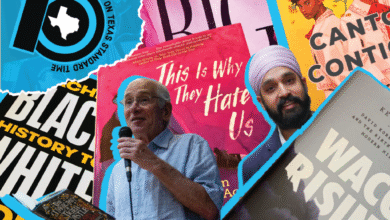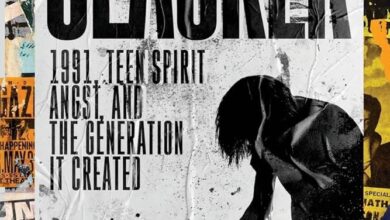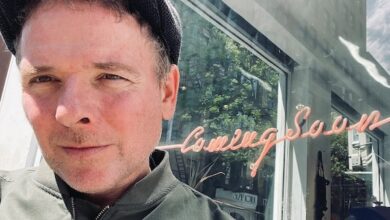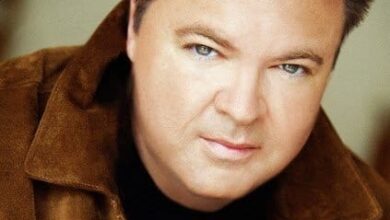Interview with Artist and Best-Selling Author Eddie Ahn – Richmond Review/Sunset Beacon

By Linda Badger
Last month, author Eddie Ahn appeared before a standing-room-only audience at the Richmond Branch of the San Francisco Public Library to discuss his new book, “Advocate: A Graphic Memoir of Family, Community, and the Fight for Environmental Justice.”
In his memoir, Ahn, the son of Korean immigrants, takes us on his life’s journey from working in his parents’ liquor store in Texas to becoming an environmental lawyer, activist, executive director of a San Francisco nonprofit, self-taught graphic artist and now the author of a bestselling graphic memoir. Ahn’s book depicts the hardships of choosing a life of community service but ultimately illustrates that he was able to achieve success on his own terms. Here are his replies during an interview session.
“Advocate” is a resounding success, a national bestseller, awarded “Best Graphic Novel of the Year” by the Washington Post and The American Library Association. Why do you think your memoir resonates with today’s audiences?
The memoir explores themes that remain challenging in today’s world – accelerating impacts of climate change, finding an appropriate work-life balance and taking care of oneself and family. There is no clean resolution, and the stories often highlight the imperfections in my own life and family. I’ve found this book continues to spur discussion and even disagreements over its meaning.
What inspired you to write “Advocate”? Why did you choose to write it as a graphic memoir?
For my parents. I wanted the visual language of comics to describe ideas and work that were very different from their own experiences, such as serving low-income communities through nonprofit work, environmental advocacy and living in San Francisco.
The book includes some humorous references to your parents being baffled that you were not using your legal education to make money. You also express some guilt about not living up to their expectations. How difficult was this for you? Have your parents learned to appreciate your choices?
This was very, very difficult. Before his loss of speech and ongoing struggle with dementia, my father never quite understood the scope of my nonprofit’s work as well as the scrappy community-building efforts of my nonprofit. However, my mother has always loved books, and despite not reading comic books, she did really enjoy my memoir and how it explored my struggles. She has read the book several times, and she mentioned that she has cried upon each reading, appreciating nonprofit work for what it is, which is as good of a result as I could have hoped for.
In your memoir, you describe your early days living in marginal sublets and limiting your diet to a burrito a day because of the high cost of living in the Bay Area. Student loans and parking fines were also a pressing financial burden. How many of our neighbors are experiencing similar pressures?
I do think everyone feels this pressure, especially in an expensive city like San Francisco. I’ve managed to survive because of a rent-controlled apartment, but I don’t think people should have to limit their diet!
Before going to law school, you describe working with AmeriCorps, a national program that places college graduates in public-service jobs. You obviously enjoyed teaching art and public speaking to kids in Oakland’s Chinatown, and the experience helped you to decide your ultimate career path. Are you concerned about the future of this program as it is now being dismantled?
Yes, I’m upset that this foundational program is being dismantled, and that the basic notion of community service is being undercut across the country. The program instills a sense of shared responsibility and generosity to others. As I travel the country for the book, I only see increasing cynicism and apathy across rural, suburban and urban communities. Dismantling this program feels like a broader dismantling of our society.
Are you still working for a nonprofit here in San Francisco?
Yes! I still work for Brightline Defense (brightlinedefense.org), the environmental justice nonprofit described in the book. Our work is split between direct services and policy work. Our direct services range from air quality monitoring, high school environmental leadership programs, to job training. Our policy work often focuses on building a clean-energy economy that is meaningful to local communities, which often involves research, analysis and engagement with state-government agencies. Through this broad range of work, Brightline staff and volunteers are trained to be better community organizers as well as serve communities with empathy.
In your book, you describe vacuuming and copying as part of your many chores as a harried executive of a nonprofit. How might the impending diminution of federal funds affect your work?
Since my earliest days of nonprofit work, I’m used to doing four or five different jobs just to get things done. While my nonprofit does not depend on federal funding for its own operations, the federal funding cuts are still devastating for states and local communities. More generally, I’m also worried about how it diminishes the effectiveness of government to deliver any services and infrastructure the people need.
In your book, you describe how your work eventually expanded into the government sector, where you have been appointed to various state and local commissions. What did you learn from these experiences?
Government plays an important role in innovating and creating large-scale responses to climate change. As an environmental and transit commissioner, I’ve learned a lot more about how the government can marshal enormous resources to create public transit infrastructure that moves people and goods throughout a sprawling region. This scale and planning can also sometimes respond to community needs more effectively than nonprofit work.
That all said, people today don’t trust government, and it’s fair to say that public trust has hit rock-bottom. In the early 1960s, four in five Americans said they could trust government to do the right thing most of the time. Today, that number is closer to 1 in 5. I do enjoy working for a nonprofit that allows me to be nimble and respond efficiently to community needs. I plan to create a comic about this in the future.
Are you currently working on any projects involving climate change? What keeps you up at night?
Yes, we’re currently working on a number of hyperlocal and statewide projects to address climate change impacts. One example is distributing air filtration systems to low-income families in Single Room Occupancy (SRO) buildings as well as schools in the San Francisco Unified School District. Another example is advocating for larger clean-energy solutions such as offshore wind, so that we’re cleaning up our grid. The timing and impact of these projects keep me up at night. Given the scale and increasing frequency of climate catastrophes, it never feels like enough and I can only hope it’s not too little, too late.
What significance does the Richmond District hold for you? Any favorite haunts?
I’ve lived in the Richmond District for most of my life, since arriving back in 2006. Green Apple Books, the two SF Public Library branches and Joe’s Ice Cream remain as sources of comfort to me. Some of my newer favorite haunts include great eats like Breadbelly and Pasta Supply Co.

You have several public art installations throughout the City, including on 10 utility boxes and a new mural on 11th Avenue and Clement Street. What does this mural represent?
I wanted to celebrate the educational programs of a nonprofit that partners with my work – the Community Youth Center of San Francisco (CYC). This mural is on their modernized community hub, which serves thousands of high school students across the City. At the edges of the mural, there are also sweeping tsunami waves, which are a nod to the Japanese printmaker Hokusai, and also represent climate change and San Francisco’s vulnerability to rising sea level.
Has your newfound success as a published author changed any future career plans?
I’m very lucky to now have a literary agent, Chad Luibl of Janklow Nesbit in New York, to help guide the next stage of my artistic career. My nonprofit is doing well, with a recent office move and expanded staffing. In the coming years, I also hope to continue expanding and deepening my artistic career with different types of storytelling. For my audience on Instagram (@ehacomics), I’ll continue to publish more short comics as well!
Do you still eat burritos? If so, who makes the best one?
Yes! Taqueria Cancún (specifically the one on Mission Street at 19th Street) remains a personal favorite because of how they toast the tortilla on the outside, but I like plenty of other taquerias!
Eddie Ahn’s memoir is available for purchase online and at a number of bookstores around the Bay Area, including one of Ahn’s favorite neighborhood spots, Green Apple Books. The San Francisco Public Library also has several copies.
Source link




